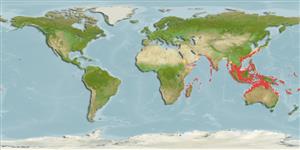Classification / Names
Common names from other countries
Main reference
Size / Weight / Age
Max length : 33.0 cm TL male/unsexed; (Ref. 9912)
Environment
Marine; demersal
Climate / Range
Subtropical, preferred ?
Distribution
Indo-West Pacific: India to China and off Cambodia (Ref. 9912). Photo records from Komodo, Indonesia (Seret, pers.comm. 01/15). Conservation status maybe of concern in Northwest Pacific because of its inshore benthic habitat, low abudance, and the presence of intensive demersal fisheries (Ref. 47737).
Countries | FAO areas | Ecosystems | Occurrences | Introductions
Short description
Preorbital length about equal to preoral length (and much greater than prenasal length), and dark brown spots that are usually greater than eye diameter over a brown background (Ref. 49866).
IUCN Red List Status (Ref. 115185)
Human uses
More information
Common namesSynonymsMetabolismPredatorsEcotoxicologyReproductionMaturitySpawningFecundityEggsEgg development
ReferencesAquacultureAquaculture profileStrainsGeneticsAllele frequenciesHeritabilityDiseasesProcessingMass conversion
Tools
Special reports
Download XML
Internet sources
Estimates of some properties based on models
Phylogenetic diversity index
PD50 = 0.5000 many relatives (e.g. carps) 0.5 - 2.0 few relatives (e.g. lungfishes)
Trophic Level
3.2 ±0.3 se; Based on size and trophs of closest relatives
Resilience
Low, minimum population doubling time 4.5 - 14 years (Assuming fecundity<100)
Vulnerability
Low vulnerability (18 of 100)
Price category
